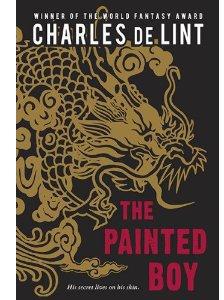
The Painted Boy
فرمت کتاب
ebook
تاریخ انتشار
2010
Reading Level
3
ATOS
4.5
Interest Level
6-12(MG+)
نویسنده
Charles de Lintشابک
9781101445341
کتاب های مرتبط
- اطلاعات
- نقد و بررسی
- دیدگاه کاربران
نقد و بررسی

October 18, 2010
Set in the American Southwest, de Lint's latest successfully blends Chinese and Mexican legends. Jay Li seems like a normal kid from Chicago, but he has a painful secret. At age 11 the image of a dragon suddenly appeared on his back and his grandmother Paupau, the family matriarch ("She's kind of like Marlon Brando in The Godfather"), revealed to him that they were both dragons. Now, however, he has dropped out of school and, with Paupau's encouragement, taken a bus across the country to the town of Santo del Vado Viejo. There he is pursued by gang members who work for the mysterious and possibly supernatural gang lord, El Tigre; Jay must make peace with the local otherworldly beings, master his powers, and defeat El Tigre. Although this contemporary fantasy is a bit talky (perhaps exacerbated by the journal Jay begins partway into the novel, through which he occasionally adds his first-person perspective on events), de Lint (Dingo) is a dependable performer, and this multicultural fusion of a gritty, modern setting with mythological elements should find fans. Ages 12–up.

October 1, 2010
A disappointing effort cobbled together from a number of mythologies and cultures, overlong and underimagined. Jay Li is a dragon: He looks like a 17-year-old Chinese American from Chicago, but, like his grandmother, he is a Yellow Dragon, which is the image that covers his entire back and grows with him. His grandmother has trained him hard but inscrutably, and she approves of his dropping out of high school and moving to a border town in Arizona, though he does not know why. There Jay finds work at a Mexican restaurant that feels a lot like his parents' Chinese restaurant. The town is held hostage by bandas—gangbangers—and several murders among his new acquaintances allow Jay to summon his inner dragon. He also touches the spirits—called the cousins—of fox, snake, coyote and jackalope in the desert and in el entre, the between. It's a mythos mashup, sometimes in Jay's whiny, adolescent voice and sometimes in that of the omniscient narrator, and there is too much telling rather than showing. De Lint is usually much better than this. (Urban fantasy. 12 & up)
(COPYRIGHT (2010) KIRKUS REVIEWS/NIELSEN BUSINESS MEDIA, INC. ALL RIGHTS RESERVED.)

December 1, 2010
Gr 9 Up-De Lint returns to the imaginary location of The Mystery of Grace (Tor, 2009) in this novel set in the American Southwest. Jay Li is a 17-year-old Chinese American transplanted from Chicago's Chinatown to the desert. The title comes from the dragon tattoo on his back, which emerged from his skin when he was 11. Jay is a member of the Yellow Dragon clan, and, thanks to a mystical family inheritance, an actual dragon on a quest to protect mankind. His quest leads him to Santo del Vado Viejo, a town overrun by bandas, gangs, where he is taken in by Rosalie and Anna. Shortly after his arrival, it becomes clear that he is there to discover his dragon nature and to free the town from the gangs. Encounters with the "cousins" (animal spirits in human form), the gang leader El Tigre, and the mysterious Rita move Jay into an uncertain future that he only half understands. The novel travels back and forth between omniscient narration and Jay's first-person journaling, and while the threads work together, they are sometimes repetitive and oddly juxtaposed. Minor discordant notes regarding cultural and local knowledge may jar readers familiar with the geographic areas or cultural communities; the mythologies of both Chinatown and Santo del Vado Viejo seem superimposed on the locales instead of emerging organically from them. Characterizations are sketchy, making it difficult to invest emotionally in the players. The moderate pace does not negate the dramatic action, however, and that may be enough for de Lint's fans.-Janice M. Del Negro, GSLIS Dominican University, River Forest, IL
Copyright 2010 School Library Journal, LLC Used with permission.

























دیدگاه کاربران